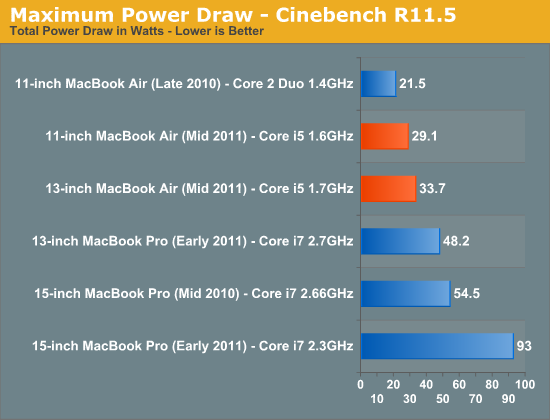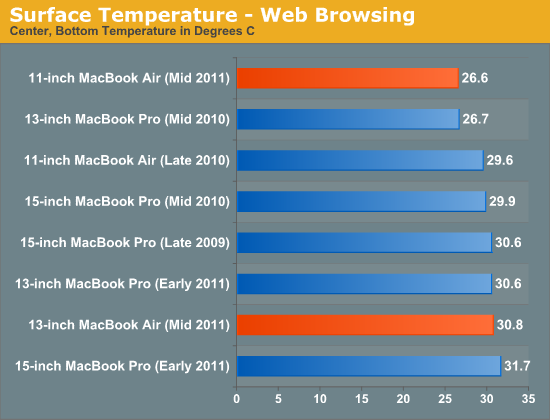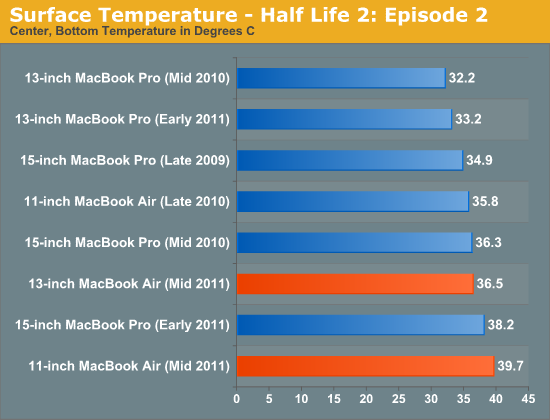The 2011 MacBook Air (11 & 13-inch): Thoroughly Reviewed
by Anand Lal Shimpi on July 28, 2011 3:25 AM EST- Posted in
- Apple
- Mac
- Intel
- Sandy Bridge
- MacBook Air
- Laptops
Thermals & Power Consumption
Both the 11 and 13-inch MacBook Air use the same 45W MagSafe power adapter as the 2010 models. To get an idea of how much power the platform as a whole uses I measured power using the same power brick and a fully charged battery on all three MBA systems (2 new, 1 old). I chose two high-load scenarios: Cinebench R11 and Half Life 2 Episode 2. The former is a purely CPU load while the latter is a good mix of CPU and GPU load.

Peak power consumption has gone up significantly since last year. The 11-inch MacBook Air draws 35% more power under full load compared to its 2010 counterpart. In Cinebench R11 however, the new 11 is over twice as fast as the old one. A 35% increase in max power for a 2x increase in performance? I'll take it.

Overall power consumption isn't too bad. You're looking at under 35W for full load on the 11 and around 40W for the 13. Neither exceeds the maximum power draw of a 13-inch MacBook Pro.
How hot are the new Airs on your lap? For the most part they aren't too bad. Under a light load the fan won't spin up and you won't feel more than 31C on your lap:

It's under load that these things can get warm. If you're just measuring surface temperature then the new 11 can hang with the 15-inch MacBook Pro:

The 11-inch MacBook Air actually has it the worst. With a more cramped chassis things seem to get hotter more quickly in there compared to the 13. However max temperature is no where near as bad as the 15-inch MacBook Pro:

Overall the thermals seem to be in line with a 13-inch MacBook Pro, despite being confined to a much smaller chassis.










103 Comments
View All Comments
OCedHrt - Tuesday, August 2, 2011 - link
35W is maximum draw I think. On average you don't use that much, and on idle you save even less. My Z, as an entire system, draws 22W on average during browsing.darwinosx - Saturday, July 30, 2011 - link
If you had actually read the review or knew anything about the Sony Z you would know that this is a different ultra low voltage i5 processor that was just released. You would also know that Sony's are higher priced, poorly made, little service and support, and run Windows.OCedHrt - Tuesday, August 2, 2011 - link
I would know that my Z runs fast, plays my games, carries around just as light as an Air, is built to last, never needed support, and cost me less. And people still have their 3 gen old Z's running core duos going strong.The Z does not want a ULV processor. ULV is only good if you want to increase your battery life at the cost of performance. The Sony Z does not lose to Air in battery life at all. Just because something just came out doesn't necessarily make it ideal. Would there be a market for the new Z with ULV? Maybe, and it will then kill the Air in battery life and probably cost even less.
KPOM - Thursday, July 28, 2011 - link
As usual, a nice and thorough review. Thanks for the comparison to the i7, as well.Apple did a nice job with this one. They have created a mainstream "ultra book" months before the others come out with their blessed-by-Intel versions. It isn't as powerful as the Vaio X, but is more reasonably priced. It beats the relatively new Samsung Series 9 (which still relies on an i3 and less powerful graphics) while maintaining similar pricing. The i7 available in the 128GB 11" is a good deal at $1349. I opted for the 256GB 11" and got the Samsung (though the Toshiba would have been fine - I had one in my 2010 MacBook Air).
OCedHrt - Tuesday, August 2, 2011 - link
I hope you mean the Vaio Z. The X was amazing but it was a paper weight.iwod - Thursday, July 28, 2011 - link
The next gen of tech, Haswell, PCI-E 4.0, Thunderbolt 2.0, Faster SSD will be perfect fit for Macbook Air.lokiju - Thursday, July 28, 2011 - link
I wonder if Sony's Air challengers external GPU would work with this if you could get the physical ports adapted to fit...A external GPU would probably be more than it's worth for me but still a cool concept.
mschira - Thursday, July 28, 2011 - link
That last sentence made me think. Why not integrate the external graphic card into the external display?That would be neat.
M.
wicko - Thursday, July 28, 2011 - link
I think I would still prefer an external GPU kit or something. This way you still have choice in GPU and in monitor, including existing ones.tipoo - Thursday, July 28, 2011 - link
I'd prefer a separate box for the GPU so you don't have to toss the display when its outdated. With thunderbolt you could potentially connect the Air to the display, then daisychain the display to the GPU.